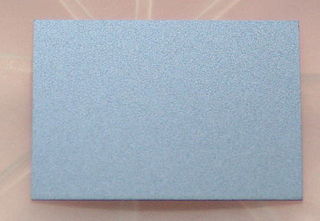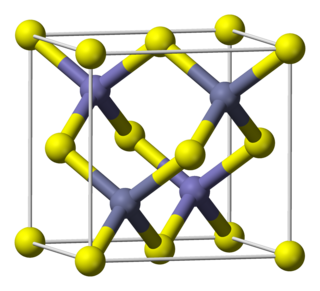Related Research Articles

Gallium arsenide (GaAs) is a III-V direct band gap semiconductor with a zinc blende crystal structure.

Indium phosphide (InP) is a binary semiconductor composed of indium and phosphorus. It has a face-centered cubic ("zincblende") crystal structure, identical to that of GaAs and most of the III-V semiconductors.
The heterojunction bipolar transistor (HBT) is a type of bipolar junction transistor (BJT) which uses differing semiconductor materials for the emitter and base regions, creating a heterojunction. The HBT improves on the BJT in that it can handle signals of very high frequencies, up to several hundred GHz. It is commonly used in modern ultrafast circuits, mostly radio frequency (RF) systems, and in applications requiring a high power efficiency, such as RF power amplifiers in cellular phones. The idea of employing a heterojunction is as old as the conventional BJT, dating back to a patent from 1951. Detailed theory of heterojunction bipolar transistor was developed by Herbert Kroemer in 1957.
Indium gallium phosphide (InGaP), also called gallium indium phosphide (GaInP), is a semiconductor composed of indium, gallium and phosphorus. It is used in high-power and high-frequency electronics because of its superior electron velocity with respect to the more common semiconductors silicon and gallium arsenide.

An infrared detector is a detector that reacts to infrared (IR) radiation. The two main types of detectors are thermal and photonic (photodetectors).

Indium arsenide, InAs, or indium monoarsenide, is a narrow-bandgap semiconductor composed of indium and arsenic. It has the appearance of grey cubic crystals with a melting point of 942 °C.

Zinc telluride is a binary chemical compound with the formula ZnTe. This solid is a semiconductor material with a direct band gap of 2.26 eV. It is usually a p-type semiconductor. Its crystal structure is cubic, like that for sphalerite and diamond.
Aluminium gallium indium phosphide is a semiconductor material that provides a platform for the development of multi-junction photovoltaics and optoelectronic devices. It has a direct bandgap ranging from ultraviolet to infrared photon energies.
Gallium arsenide phosphide is a semiconductor material, an alloy of gallium arsenide and gallium phosphide. It exists in various composition ratios indicated in its formula by the fraction x.

Gallium antimonide (GaSb) is a semiconducting compound of gallium and antimony of the III-V family. It has a room temperature lattice constant of about 0.610 nm. It has a room temperature direct bandgap of approximately 0.73 eV.
Gallium indium arsenide antimonide phosphide is a semiconductor material.
IQE PLC is a British semiconductor company founded 1988 in Cardiff, Wales, which manufactures advanced epitaxial wafers for a wide range of technology applications for wireless, optoelectronic, electronic and solar devices. IQE specialises in advanced silicon and compound semiconductor materials based on gallium arsenide (GaAs), indium phosphide (InP), gallium nitride (GaN) and silicon. The company is the largest independent outsource producer of epiwafers manufactured by metalorganic vapour phase epitaxy (MOCVD), molecular beam epitaxy (MBE) and chemical vapor deposition (CVD).
Indium gallium arsenide phosphide is a quaternary compound semiconductor material, an alloy of gallium arsenide, gallium phosphide, indium arsenide, or indium phosphide. This compound has applications in photonic devices, due to the ability to tailor its band gap via changes in the alloy mole ratios, x and y.
A light-emitting transistor or LET is a form of transistor that emits light. Higher efficiency than light-emitting diode (LED) is possible.

Rubin Braunstein (1922–2018) was an American physicist and educator. In 1955 he published the first measurements of light emission by semiconductor diodes made from crystals of gallium arsenide (GaAs), gallium antimonide (GaSb), and indium phosphide (InP). GaAs, GaSb, and InP are examples of III-V semiconductors. The III-V semiconductors absorb and emit light much more strongly than silicon, which is the best-known semiconductor. Braunstein's devices are the forerunners of contemporary LED lighting and semiconductor lasers, which typically employ III-V semiconductors. The 2000 and 2014 Nobel Prizes in Physics were awarded for further advances in closely related fields.
Aluminium indium antimonide, also known as indium aluminium antimonide or AlInSb (AlxIn1-xSb), is a ternary III-V semiconductor compound. It can be considered as an alloy between aluminium antimonide and indium antimonide. The alloy can contain any ratio between aluminium and indium. AlInSb refers generally to any composition of the alloy.
Gallium arsenide antimonide, also known as gallium antimonide arsenide or GaAsSb, is a ternary III-V semiconductor compound; x indicates the fractions of arsenic and antimony in the alloy. GaAsSb refers generally to any composition of the alloy. It is an alloy of gallium arsenide (GaAs) and gallium antimonide (GaSb).
Indium arsenide antimonide, also known as indium antimonide arsenide or InAsSb (InAs1-xSbx), is a ternary III-V semiconductor compound. It can be considered as an alloy between indium arsenide (InAs) and indium antimonide (InSb). The alloy can contain any ratio between arsenic and antimony. InAsSb refers generally to any composition of the alloy.
Gallium indium antimonide, also known as indium gallium antimonide, GaInSb, or InGaSb (GaxIn1-xSb), is a ternary III-V semiconductor compound. It can be considered as an alloy between gallium antimonide and indium antimonide. The alloy can contain any ratio between gallium and indium. GaInSb refers generally to any composition of the alloy.
Aluminium arsenide antimonide, or AlAsSb (AlAs1-xSbx), is a ternary III-V semiconductor compound. It can be considered as an alloy between aluminium arsenide and aluminium antimonide. The alloy can contain any ratio between arsenic and antimony. AlAsSb refers generally to any composition of the alloy.
References
- ↑ Shur, Michael; Suris, R. A. (2020). Compound semiconductors 1996 : proceedings of the twenty-third International Symposium on Compound Semiconductors held in St Petersburg, Russia, 23-27 September 1996. Boca Raton. p. 552. ISBN 978-1-000-15712-3. OCLC 1222799133.
{{cite book}}: CS1 maint: location missing publisher (link) - ↑ Rogalski, Antoni (2011). Infrared detectors. Boca Raton, FL: CRC Press. p. 346. ISBN 978-1-4200-7672-1. OCLC 690115516.
- ↑ Martí, Antonio; Luque, A. (2004). Next generation photovoltaics : high efficiency through full spectrum utilization. Bristol: Institute of Physics. p. 265. ISBN 978-1-4200-3386-1. OCLC 80745662.
- ↑ Kuech, Tom (2014). Handbook of crystal growth. Vol. III, Thin films and epitaxy: basic techniques. Burlington: Elsevier Science. p. 267. ISBN 978-0-444-63305-7. OCLC 913620060.